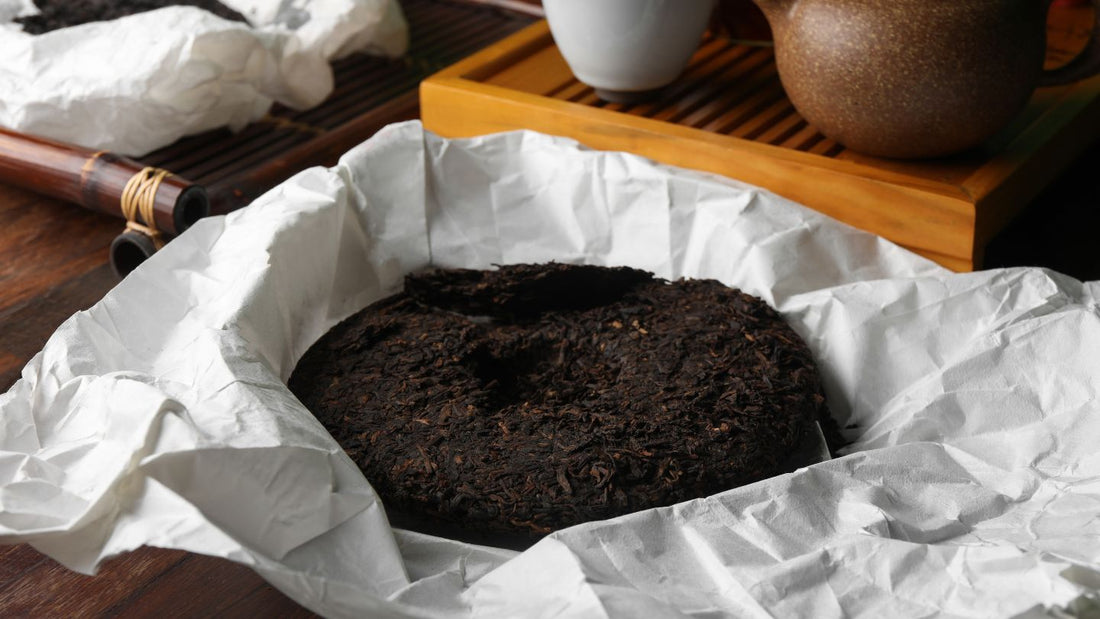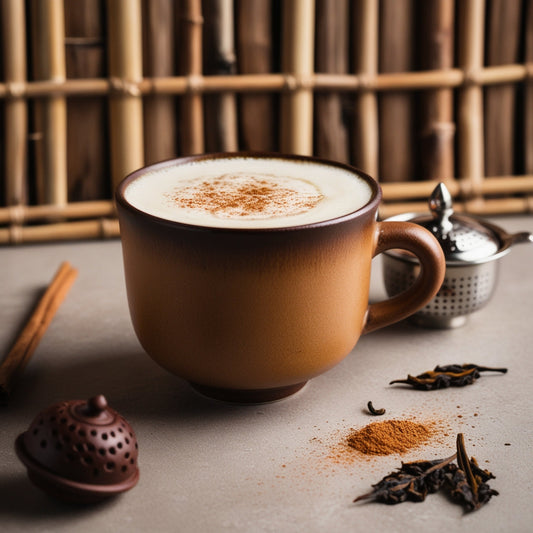Overview
Did you know ? To best enjoy Pu-erh tea you have to store it perfectly or source only those Pu-erh tea which are stored correctly so that you don't lose the essence of it.
Pu-erh tea, a distinctive and traditional Chinese tea, has unique storage requirements that are essential to maintain its quality and enhance its flavor over time. This article explores the proper methods to store Puerh tea, highlighting the importance of air circulation, stable temperature, and appropriate humidity. Additionally, it delves into other factors affecting the taste, such as the surface area of leaves exposed to oxygen and the choice of storage container.
Table of Content
- Introduction
- What is Pu-erh tea
- How to make Pu-erh tea
- How to store Pu-erh tea
- The right way to store Pu-erh tea
- Conclusion
Introduction
Pu-erh tea originates from the region on the border of China, Burma, and India, where researchers believe the earliest tea plants grew. Farmers grow the leaves for Pu-erh tea along the Lancang River in the Yunnan province, and manufacturers then package them for worldwide shipment. This tea has a rich history and tradition, with its aging process being an integral part of its distinctive character.
Pu-erh tea comes in two main types: Sheng (Raw, Uncooked) and Shou (Ripe, Cooked, Fermented). For centuries, all Pu-erh tea was green tea.
However, in 1975, the Menghai Tea Factory introduced a new processing method to create "black" Puerh tea, mimicking the natural aging process through a step called piling/heaping. This method allows new teas to develop an aged taste.
What is Pu-erh tea
On the border of china , Burma and india is where the very first tea plants are said to have been found from which all varietis of tea producing plants originated Leaves for Pu-erh tea are grown along the lancing river in the Yunnan province these leaves are then packaged to be shipped to your homes.

How To Make Pu-erh Tea
English speakers often use linguistic phrases about Chinese tea that originated in different eras, preserving them through history and tradition. Interestingly, the term "post-fermented teas" is a bit misleading. These teas don't actually ferment after production, as true fermentation occurs only without air. Instead, they age through oxidization when exposed to air.
The world of Pu-erh tea adds another layer of complexity. There are two main types: Sheng (Raw) and Shou (Ripe). For 1,500 years, all Pu-erh was green tea. However, in 1975, Menghai Tea Factory revolutionized the industry. They introduced the first commercial "black" Pu-erh tea cake, cleverly mimicking nature's aging process to give new teas an old taste.
This innovative process, called piling or heaping, involves stacking tea leaves to encourage fermentation. The resulting chemical reactions heat the leaves slightly, creating a unique flavor profile. Thus, tea makers transformed a centuries-old tradition, adapting it to modern demands while preserving its rich heritage.
How to Store Pu-erh tea
Pu-erh tea is packaged usually one of two ways either as a loose leaf or compressed tea and there are 3 factors that affect the micro organisms in your tea.
- Air Circulation
- Stable Temperature
- Appropriate Humidity
Air Circulation
The health of microbes in the tea leaves is ensured only by good air circulation, which in turn helps to keep the processes that result into the distinctive aromatic compounds needed for a well-aged Pu-erh tea going on. On the other hand, if air circulation is drastically diminished, it will directly affect these processes and make the taste flat with weak aroma.
To aid aging in your Pu-Erh tea, you need to expose it to some fresh air or refresh its surroundings from time to time. For instance, sealed vessels and tiny spaces such as cupboards or compartments that are under beds can be disadvantageous since there may not be much access to fresh air.
Stable Temperature
Micro-organisms prefer a stable temperature environment to encourage reproduction. According to past experience, a temperature range between 20° to 30° Celsius (68° – 86° Fahrenheit) is ideal to maintain long term transformation of the leaves. Of equal importance is that temperature fluctuations occur slowly if one lives in a climate where the temperature shifts dramatically or often.
It is important not to store Pu-erh tea near a heater, open window or in a refrigerator where the temperature may be too hot or too cold or may shift too rapidly.
Appropriate Humidity
Tea leaves are excellent at soaking up moisture from the air. An appropriate stage of humidity can help the replica of micro-organisms and excessively low humidity hinders replica. Additionally, immoderate high humidity and absence of air stream can lead to the development of mould that can break a tea.
Tea leaves are also excellent at absorbing odours so it's miles vital now not to store Pu-erh tea in kitchens, washrooms or everywhere close to heavy water utilization.
An additional aspect is light. Bright light slows micro-natural growth, so low light situations are the most appropriate for storing Pu-erh tea.
More Factors Affecting Taste:
In addition to air, temperature and humidity, there are 3 more factors that affect taste:
- Surface area of leaves exposed to oxygen during storage
- Storage container
- History
Surface area of leaves exposed to oxygen during storage
Like maximum Chinese teas, Pu-erh tea is made from hand-picked complete leaves as opposed to Indian teas that are made from leaves which are damaged; the end result of mechanized processing techniques. It is critical that the process of breaking up the tea leaves be done lightly and patiently so the leaves aren't damaged, that could exposes the inner structure of the leaves and purpose them to dissolve erratically, creating bitterness in the tea while it's far brewed.
Storage Container
Find a suitable container for storing the concentrated tea, breaking it or leaving it in its original state. The more air and moisture-resistant the container, the slower the growth rate. Paper bags are an inexpensive and effective way to store broken tea. Broken teas can be stored in cardboard boxes but the best choice is in sturdy, unglazed ceramic pots, preferably with Yixing clay, the same material used to make Chinese tea pots. Plastic containers can produce unwanted particles that can affect the taste in the long run. Be sure to check each pot for unique odors that the tea may absorb.
The Right Way To Store Pu-erh Tea
Improper storage of Pu-erh tea can significantly affect its quality and taste. Without adequate air circulation, the tea may lose its distinctive aroma and become flat. If stored in fluctuating temperatures or in environments that are too hot or cold, the tea's aging process can be disrupted, leading to a less desirable flavor. High humidity levels without proper air circulation can cause mold growth, ruining the tea. Additionally, storing Pu-erh tea near strong odors can result in the tea absorbing these smells, negatively impacting its taste.
Conclusion
Storing Pu-erh tea correctly is essential to preserve its unique qualities and enhance its flavor over time. By ensuring proper air circulation, stable temperature, appropriate humidity, and low light exposure, you can maintain the health of the micro-organisms that contribute to the tea's aging process. We at Pu-erh Craft make sure that our customers enjoy the best Pu-erh tea by sourcing only perfectly sourced Pu-erh.
Additionally, handling the leaves gently and choosing the right storage container can further improve the tea's taste. Following these guidelines will help you enjoy the full potential of your Pu-erh tea for years to come.
Explore our collection at Pu-erh Craft for the best stored Pu-erh tea.
Q&A Section
Q: Can I store Pu-erh tea in the refrigerator?
A: No, storing Pu-erh tea in the refrigerator is not recommended. The temperature in refrigerators is too cold and can fluctuate, which disrupts the aging process. Additionally, the tea may absorb odors from other foods stored in the refrigerator.
Q: How often should I expose Pu-erh tea to fresh air?
A: It is beneficial to expose Pu-erh tea to fresh air periodically, such as once every few months. This helps maintain the health of the micro-organisms and ensures the aging process continues smoothly. However, avoid excessive exposure, as it can lead to too much moisture absorption.
Q: What is the ideal humidity level for storing Pu-erh tea?
A: The ideal humidity level for storing Pu-erh tea is between 60% to 70%. This range supports the reproduction of micro-organisms without causing mold growth. Avoid excessively high or low humidity levels to prevent damage to the tea.
Q: Can I store Pu-erh tea in a plastic container?
A: It is best to avoid plastic containers for storing Pu-erh tea, as they can release unwanted particles that may affect the tea's taste over time. Instead, opt for air- and moisture-resistant containers like paper bags or unglazed ceramic pots.
Q: Is it necessary to break up Pu-erh tea cakes before storing?
A: Breaking up Pu-erh tea cakes before storing is not necessary. However, if you choose to break them, do so gently to avoid damaging the leaves. Storing the tea in its original state can help preserve its quality and ensure even aging.






